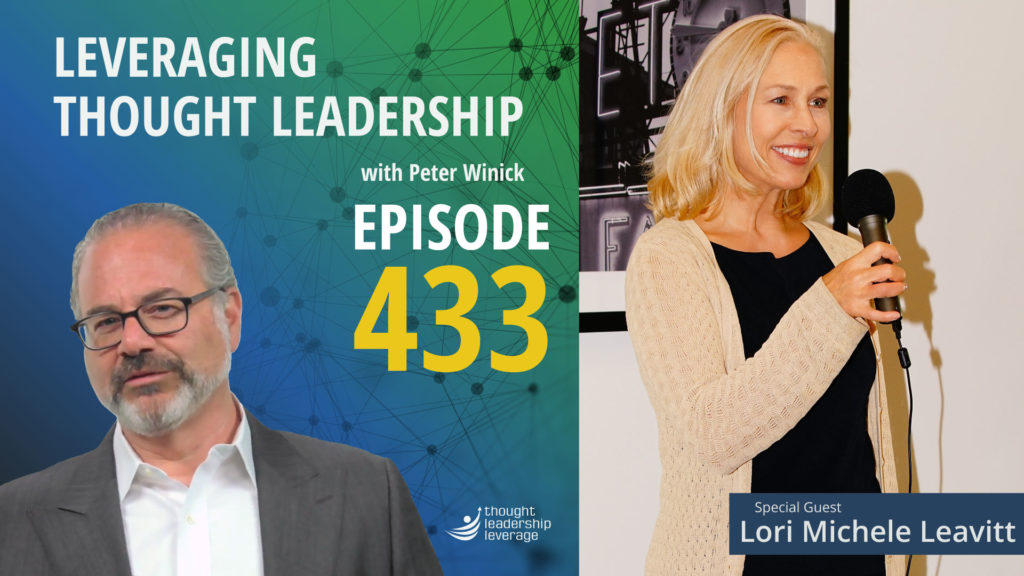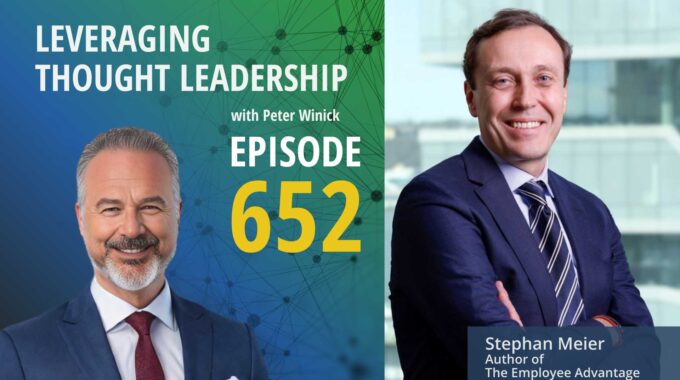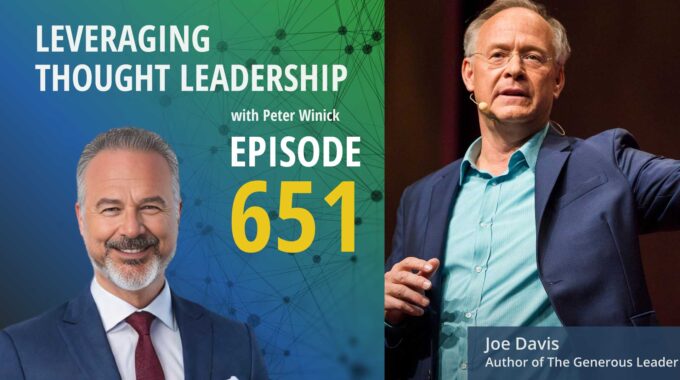The Hidden Barrier to Engagement and How to Break Through This episode unpacks how cultural…
Helping Leadership Pivot | Lori Michele Leavitt

How a good program and software can make pivoting easier.
An interview with Lori Michele Leavitt about becoming the “Pivot Catalyst,” and elevating content through various modalities.
When businesses talk about “making a pivot,” it’s often thought of as something that must happen quickly and with great impact.
The reality is – a successful pivot is often anything but quick, and true impact can be difficult to implement.
Who better to discuss bringing big changes to organizations than the “Pivot Catalyst,” Lori Michele Leavitt! Lori the founder and President of Abridge Corp, as well as an accomplished coach, consultant, trainer, speaker, and author of The Pivot: Orchestrating Extraordinary Business Momentum.
Lori shares her insights on bringing about large-scale business changes, from building momentum to bringing people on-board with the shift in mindset. If you want to make a pivot, the leadership of the organization needs to encourage the adoption of many small changes by many people over time – not demand massive changes all at once! Momentum and buy-in are both key to any lasting change.
Lori has guided many businesses and leaders through this kind of process, and has learned a great deal about organizations undergoing large-scale change. She shares how she turned her processes into a book, and later, software that she continues to iterate. She’s moved the needle on management software, building a leadership operating system called Aligned Momentum.
Codifying your message and process into a book is complicated, but it’s another step to then turn your content into software! Lori shares insights into the process she went through with her content, sharing her insights into the future of consulting software as it continues to evolve.
Three Key Takeaways:
- Helping an organization successfully pivot starts with getting the cultural decision-maker on board with change.
- Being the smartest person in the room isn’t the best way to have a lasting impact as a coach.
- Change often happens faster in a safe space, and it’s good to have peers and allies to help identify your blind spots in the process of organizing and driving change.
If you need a strategy to bring your thought leadership to market, Thought Leadership Leverage can assist you! Contact us for more information. In addition, we can help you implement marketing, research, and sales. Let us help you so you can devote yourself to what you do best.
Transcript
Peter Winick And welcome, welcome, welcome. This is Peter Winick. I’m the founder and CEO at Thought Leadership Leverage. And you’re joining us on the podcast today, which is Leveraging Thought Leadership. Today, my guest is Lori Michelle Leavitt. And Lori is the pivot catalyst. She has consulted and trained hundreds of leaders around the world to achieve their objectives and generate extraordinary momentum. She’s a speaker. She’s the founder of the Bridge Group, which offers the Aligned Momentum Program and software to help managers lead. When she’s not writing one of her favorite getaway locations conducive to deep thought creativity. She’s supporting orchestration, pivots, decision making and judgment calls for business leaders and their teams around the world. Anyway, here we are. So that’s an interesting bios.
Lori Michelle Leavitt So thank you. Yep, that’s me.
Peter Winick Tell me first, tell us how you got here and then let’s talk about what it is. So how did you get to be the pivot queen, if you will.
Lori Michelle Leavitt Pivot catalyst? I hate being called queen. Okay. So, there you go. You know, I’ve been in a role of decision support all my life, which has been a long time. And what I realized; I became an entrepreneur. Well, I guess I’d say I went out on my own. I really didn’t understand that I was an entrepreneur. We just didn’t do that back then. And then I realized once I realized I was an entrepreneur, I realized, oh, that’s what happened in corporate. All the higher ups loved me, but my team didn’t like all the changes and the achievement and all the stuff that I wanted to do. But decision support was really important to me. I still do that. And as the pivot catalyst well changes all the time. And what I found was that the term why I wrote my first book in 2017 and this’ll kind of answer your question of why I’m why I’m also in this role is that I kept talking about the pivot as being super-fast. And I agree that in startups, if you’re saying I’m going after this market, I’m now going to go after this market, that’s I said that pretty quickly. But you know what? It’s not fast. And in the organizations that I work with. If you want your organization to be able to pivot, then you as a leader need to orchestrate many small shifts by many people over time.
Peter Winick So stay there for a moment, if you will, because at some point there are times where. You know, I’m hearing people talk about pivot and I’m getting a headache and I’m getting nauseous because it seems like, oh, you got to be pivoting every day. I’m like, no, that’s like a roller coaster ride. So how are you defining pivot? Because I have one way I think about all of this the right way. But how are you? What’s your definition of a smart pivot?
Lori Michelle Leavitt So I define a pivot as a significant change, which is in some ways how it’s used. And in this book, I’m referencing my compelling I’ve got to write this book came up in 2013. It’s been a while. I published it in 2017. It took me a while to get over that. Who do I think I am to be telling business leaders? They have to think of it this way. And then I got over that and I sent the book as the gift. It is out into the world, but it is it is a shift over time. It’s not a project. That’s right. But the way other way of we address it and it is not if you treat it as a project, you’re going to have to push all over again.
Peter Winick Right? So I think one of the variables there is time. So I think in today’s or when I’m hearing that language more frequently today, there’s an implication that it’s rapid, right? That a pivot has to be rapid. And I think that probably comes from the agile movement in technology. You know, like, listen, if you have limited funds and you just raised some money and you only have this much runway and it’s not working, you better pivot. But to get a Fortune 500 to pivot, that’s a whole different turning of a massive, massive shift. So how would you think about pivots differently for, let’s say, individuals, teams and organizations?
Lori Michelle Leavitt And so an individual pivot or let’s say that smaller shift can be quick. I’ll give you an example. People think I’m happy all the time. I’m not happy all the time. I have learned to shift my emotional state quickly, but I had to learn it over time. And that’s a very simplistic example. But apply that to something that you want to have different about your life. And you haven’t even pinpointed yet how you need to change. Because of course it takes a long time for one of the reasons I, I lead peer groups is because those things happen quicker when you have peers around you that can that are it’s a safe place and they can identify your blind spots where you’ve said, hey, I kind of don’t, oh, it’s because of this. And so, it’s even in yourself. It takes time. You can make small shifts toward it. But that pivot, that significant I’ve shifted from this place to this place is going to take some time and we need to give ourselves some time and not give up.
Peter Winick I love it. So, talk for a moment if you would, about the under the business model. So how who’s hiring you to do what? What does that look like?
Lori Michelle Leavitt So typically it’s I would say it’s bucketed under two things. One, one category, they might call it performance management, although I don’t like that term anymore. I shift it to performance momentum because as managers, which is why in my bio it says I help managers, lead managers who manage work. You don’t manage people. You lead people.
Peter Winick Right?
Lori Michelle Leavitt Right. So it’s really performance. Momentum is a system of, okay, we’re managing work, but we also have a system where we’re leading people and we understand the importance of that. Those around us understand the importance of that, and we have time expenditures to do that so that what is.
Peter Winick Like then is as an intervention. So, what is the how does it start? Where does it what’s involved? Like what does that look like?
Lori Michelle Leavitt Yeah, well, typically when I’m working with an organization, it’s always starting with the. The decision makers of culture tend to be the senior leadership team. Okay, I’m really working on my wording to not say it starts at the top or it’s at levels and etc. because organizations aren’t necessarily hierarchies anymore. But whoever is that that person or that body of people that are making decisions about the culture, typically the senior leadership team is starting, and they need to commit and understand that, hey, we are asking our managers to lead better so. How do we need to change in our expectations?
Peter Winick So are those interventions. You coming in as a consultant? You coming in as a coach? Are there tools? Give me give me that right. Some of the business models.
Lori Michelle Leavitt Okay. So one is a consulting model where I am going into an organization and working through finding out what they want. What are they going to need to do to orchestrate that change? And the framework is the same for everyone. But where people are in the cycle and what they need most from the framework differs for every organization. The other thing is that.
Peter Winick Classic confronting consulting on the front end. Do the diagnostic dove in and figure out what the problems are, etc. Identify them, talk to leadership about what you’ve uncovered and then come to some sort of agreement around the interventions in the path forward.
Lori Michelle Leavitt That’s correct. And some of those models include software. One of the things that I do is architect software. I don’t code, but I will bring it in and it will power me to do better work. They may buy the software after, but it provides the more de-identified data gathering and it just helps us move more swiftly and surely through it because we have this software impact.
Peter Winick That a little that’s really interesting. So there’s so.
Lori Michelle Leavitt The software and.
Peter Winick There’s software that you’re using that clients can also license or utilize on their own at some point.
Lori Michelle Leavitt Yes, exactly. So, the software that I initially did this back in 2001 was for it helped many organizations, health care organizations, move to the hippie HIPA privacy security regulations. And it was primarily a gap assessment and closure, a discovery application, which I still have. But the difference about it was that we brought it in in a way where they improved performance along the way. It wasn’t just a compliance thing. If we’re going to do this with your entire enterprise, let’s make you better while we’re doing it now. We’ve evolved and we’re actually just launching our software and and working with a few and actually looking for a few more. I’m going to call them beta clients, clients that will also bring us and so that we’re sure we are doing this right within the organization and it’s moving as smoothly as possible. We call it aligned momentum and it is a leadership operating system.
Peter Winick If you’re enjoying this episode of Leveraging Thought Leadership, please make sure to subscribe. If you’d like to help spread the word about our podcast, please leave us a review and share it with your friends. We’re available on Apple Podcasts and on all major listening apps as well as at ThoughtLeadershipLeverage.com/podcasts.
Peter Winick Stay there for a moment, because this is fascinating to me, so I want to go in a little bit of a different direction. So, you’ve got your thought leadership, you’ve got your IP. You’ve been at this quite some time. It lives in books. It lives in various states. Unpack for me if you if you would, the process by which you take your ideas that start in your head and codify them to the point where they could literally be a piece of software, because that’s people have a hard enough time codifying a methodology into a framework or into a training program or whatever, but literally turning it into code. And I’m not worried about the technical side of good, but how do you break that down? How do you do that? How you even.
Lori Michelle Leavitt Oh, Peter, that’s such a good question. It is a good question because you know, when you. When something comes naturally to you or when you have a creative side, it’s difficult to explain.
Peter Winick And that’s the curse of the expert, where you can immediately, at the speed of light, get to the answer. And I’m still thinking about it. And we know what the problem is. And then I ask you to break down how you did it. And you realize there’s 882 steps that were in your brain that aren’t even in my slow brain. So I totally understand.
Lori Michelle Leavitt And I love that you said that. I tell you as as I also took on the role of coach, I unlearned a lot of my consulting ways. Yes. Because being the smartest person in the room is not the way to have lasting impact.
Peter Winick I mean, it’s the way to break through is as a consultant.
Lori Michelle Leavitt It is.
Peter Winick Yes. So talk about.
Lori Michelle Leavitt Anyway, so how do I do this? All right. So, I’m going to I’m going to go back to the example of Hippo only because I think it’s easier for people to understand when I explain it. So here was an industry that all of a sudden had a regulation that no one was an expert on it, and it was a huge rag, I don’t know, 300 pages or something like that, where you could tell that a bunch of different departments had worked, groups had worked on it. So, there were inconsistencies, things that didn’t make sense. And I know business. And so, I knew organizations were going to have a group of people that looked at it that might. Understand it or might not. We’re going to come up with policies for it and they’re going to tell everybody that’s the rig that they were actually their policies. So, I knew all of that stuff was. Yeah. And I also saw that health care organizations were reaching out to medical records experts because it’s protected health care information, which had no idea how our organization ran.
Peter Winick Right.
Lori Michelle Leavitt Or attorneys, because that’s a compliance issue which had no idea how an organization ran.
Peter Winick And they were so good at being know. Right.
Lori Michelle Leavitt It’s the typical entrepreneur like, oh, my gosh, I’ve got to solve that. Okay. You know, and there was a deadline to it. And so, I dove through the rig and I created a jump start out with this spreadsheet of all the questions and who I need to ask those questions and how they would move through it and then work with a development team to create it into a software. And we actually sold I was like $7 million worth of it in 18 months. It worked. Yeah, it did pretty well. I even had one organization that was working. I won’t name them, but they were a project team working with a very well-known organization and they were near the end of the deadline, and they couldn’t get through it because they were asking the right questions. And they bought my Excel spreadsheet.
Peter Winick Oh, right. But I think it’s interesting because very few thought leaders. I mean, there were. There are those out there who have turned their processes, their thinking, their methodologies into software. And I’m always fascinated by the process by which they’ve gone about doing. You know, it’s one thing to create an assessment tool where something that you could do on paper you’re digitizing, but literally turning into a piece of software that others can use that’s very different. So, thanks for sharing.
Lori Michelle Leavitt You know what the hardest thing is? The hardest thing. And I think that engineers deal with this, too, is whittling it down to what is necessary to start what they call in the startup world the minimum viable product. Why is.
Peter Winick It critical? You know, it’s funny that you say that because in my work with authors and thought leaders and all that, you know, someone might come to me at a stage in their career where they’ve been at it for 20, 30 years. And here’s the stack of books they’ve written, all the work they’ve got. And I’m like, Give me down to the essence. Write and give me, you know, what is the minimum viable if you only have a half an hour to convey some information? To me, that’s the gist or the distillation of your life’s work. What is that? And it’s really, really hard for a lot of folks to be able to do that. Well.
Lori Michelle Leavitt That’s right. And so, for a line momentum, because I do so many things, we have done a balanced scorecard with large organizations, this and that. And I’m thinking, okay, I want the shift from management software to leadership software. What does it really need? If I put measurement in it, it’ll be a cool thing, but it’s going to look too much like management. We’re not going to put that in yet, even though we’re good at it and we can do it.
Peter Winick And that takes a tremendous amount of discipline, though, because he hasn’t.
Lori Michelle Leavitt Really had to whittle that.
Peter Winick Oh, but this is so.
Lori Michelle Leavitt Yeah. And I spent millions on it. I want to use it. Right. But, you know.
Peter Winick So. How do you find then again, on the business side of the house, there’s marketing and selling, consulting, there’s marketing and selling services, and then there’s marketing and selling software. How are they similar and how are they different in your experience?
Lori Michelle Leavitt Well, not so. I don’t do marketing or selling of software tools or any of that. So these are all I’m going to say. They’re going to be bucket list management and I’m calling them leadership software.
Peter Winick Okay. But so then let me rephrase the question then. How are you going about selling and marketing the things that you do as a.
Lori Michelle Leavitt Okay. So, with the HEPA I my, my best step was becoming a national speaker actually global because some other countries were interested in what we were doing here with respect to privacy, security. So that made me visible. Again, not a lot of experts. It wasn’t a muddy market and therefore there were only a few of us that were speaking in a way that CEOs understood.
Peter Winick Okay. So, speaking brings the awareness. So, it’s a great way. And you saw an opening in that market. So, if you were to go into a different space and say, oh my God, there’s 300 speakers talking about resilience, okay, that’s crowded. But when you went in, you saw an open market.
Lori Michelle Leavitt Progress, a line momentum is a little bit more difficult. And I’ll tell you what’s the most difficult. Yeah. Is social media. Oh, my word it all. It’s like you got to be there and I’m not going to be dancing around.
Peter Winick Yeah, but social I mean, I agree with a couple of asteroids there. Mastering each platform on social media is mind blowing because the algorithms change and the best practices change and is, you know, is clubhouse is going to be here or whatever. But I think if you’ve got a tight strategy in place, those are just tactics. And then you look at those tactics and say, this is, you know, who’s my market is my market on TikTok. No. Okay. I can draw an extra to that one. Don’t need to go there right now. Yes. If you’re selling something maybe more visual or whatever or to a younger market and your market is on TikTok and that’s you know, that’s not in your sweet spot, then you do have a problem. You do have to figure it out.
Lori Michelle Leavitt Yes. And so, our strategy for a line momentum is there. There are a few clients that we’re going to directly, but they’re primarily referral sources that are saying, you know, we’re working with this organization, or we know of this organization and we really think that they would be a great one for you to work with.
Peter Winick So that’s a big that’s a great and our strategic partners.
Lori Michelle Leavitt And for the future, it will be that we’ll have this down well enough that the program part of it not the software but the program part of it due to allow other consultants to step in and do that program and bring the software in with them.
Peter Winick Got it. Well, this has been great. Any final words of wisdom or.
Lori Michelle Leavitt Are you thinking about doing a software for the interested? Do you have software?
Peter Winick No, no. But a lot of our clients, we’ve worked with them to do that. It’s a difficult process and to do it well, but to really create the operating system version of what you do is great. Now we do not have the software.
Lori Michelle Leavitt Yes, well, if you had that bug to create, it’s like you’re not alive. I don’t feel like I’m living unless I’m creating some gift. It’s my books, the software. It’s something like.
Peter Winick That. Well, thanks so much for your time. Appreciate it, Lori. Thank you.
Lori Michelle Leavitt Thank you. Bye bye.
Peter Winick To learn more about Thought Leadership Leverage, please visit our website at ThoughtLeadershipLeverage.com to reach me directly. Feel free to email me at Peter at ThoughtLeadershipLeverage.com and please subscribe to Leveraging Thought Leadership on iTunes or your favorite podcast app to get your weekly episode automatically.






